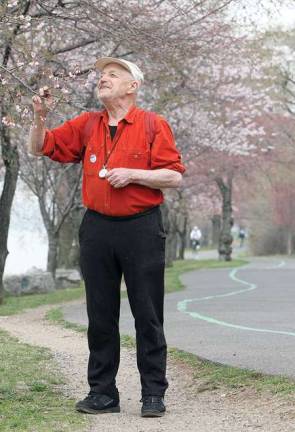The Walking Man: Cy Adler releases new book and prepares for The Great Saunter

By Sean Creamer Born in Bensonhurst, Brooklyn, in 1927, Cyrus A. Adler, or Cy as he likes to be known, is the walking guru of Manhattan and an icon along the park trails of the Upper West Side. His exploits have led to him publish books about two trails that he, with the help of his non-for-profit organization The Shorewalkers, created: The Great Saunter and the Battery to Bear Mountain. His activism helped create Hudson River Park, which then fostered the growth of The Great Saunter, a 32-mile hike that circumnavigates Manhattan. While Adler may have a yen for solid ground, he originally studied the seas. After working as an oceanographer, he turned to education, teaching oceanography, math and physics at City College of New York, LIU and other schools. It was around this time that Adler began to view walking as more than just a means to get around. "I was married and I was teaching, so I decided to lead some hikes for a group called the Appalachian Mountain Club [AMC]," said Adler. "All the walks I would lead were along the water. In the late '70s and early '80s, Adler began to push for the conservation of Manhattan's coastline, focusing on the West Side. A boom in the shipping industry had left a plethora of shipping containers stacked like unused Legos along the Hudson River. This is what pushed him to hold the first Great Saunter and was the foundation for The Shorewalkers. "After hiking with AMC for a while, I decided that it would be easier to do it on my own," said Adler. The first unofficial Great Saunter was held in 1982. Adler put an advertisement in the Village Voice for people to join him on a stroll along the area. This walk helped to sow the seeds for Hudson River Park, one of the many routes of The Great Saunter. The next Saunter will take place May 5, as The Shorewalkers celebrates the 27th year of the event and its 30th anniversary promoting walking and shoreline conservation. "For the first Saunter, we headed east and we held it on the longest day of the year," said Adler with a shudder. "This was a mistake. We had the sun in our faces walking up the East Side and it scorched us as we walked down the West Side." The years and years of walking the rim of Manhattan led Adler to write the book Walking Manhattan's Rim: The Great Saunter, which covers his history on the streets and shores of Manhattan. He details the trail and each park, neighborhood and culture that he found along the way. The Saunter leads wayfarers through over 20 different parks and promenades and a dozen historic communities and gives view to the many cultures of New York City. Those who finish are honored at the Heartland Brewery on Fulton Street about 12 hours later. One of his favorite places on The Great Saunter is the Cherry Path just off West 100th Street. It delivers an iconic view of the George Washington Bridge along the Hudson River, but the pavement has been deteriorating in recent years. "This area was a 'desire path' made by walkers and joggers and it has a crack in it. It's been cracked for two years," Adler said. He tried to reach out to the Parks Department and Community Board 7 to repave the walk so walkers can focus on avoiding "freewheeling bikers" instead of watching out for large ruts in the path. A makeshift fence has been put up so far, but the holes have not been filled. The Cherry Path is also part of the 56-mile "Batt 2 Bear" trail, the focus of Adler's newest book: Walking the Hudson: From The Battery to Bear Mountain. As the name suggests, the trail begins in Battery Park, takes walkers over the George Washington Bridge and leads them along the coast of the Hudson River to the foot of Bear Mountain. The book discusses the trail into 11 chapters and catalogues each of the sights, stops and histories to be found along the way. The last hike Adler led was on this same trail about a month ago. He and the group passed over the George Washington Bridge onto the Palisades and down 400 steps to the shore of the Hudson River. They walked along the edge and went back afterward. "No New Yorker should die without walking over the George Washington Bridge," said Adler.